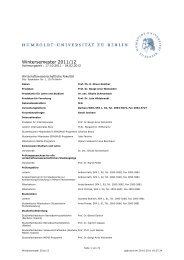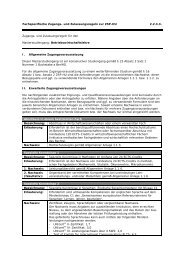Measuring the Effects of a Shock to Monetary Policy - Humboldt ...
Measuring the Effects of a Shock to Monetary Policy - Humboldt ...
Measuring the Effects of a Shock to Monetary Policy - Humboldt ...
You also want an ePaper? Increase the reach of your titles
YUMPU automatically turns print PDFs into web optimized ePapers that Google loves.
Bayesian FAVARs with Agnostic Identification 19<br />
<strong>the</strong> statement that more data necessarily means more information and hence better for<br />
<strong>the</strong> analysis seems not <strong>to</strong> be <strong>the</strong> end <strong>of</strong> <strong>the</strong> s<strong>to</strong>ry.<br />
The dynamics <strong>of</strong> <strong>the</strong> ”informational” variables is assumed <strong>to</strong> be like <strong>the</strong> following:<br />
X ′ t = Λ f F ′<br />
t + Λ y Y ′<br />
t + e ′ t<br />
(5)<br />
et ∼ N(0, R) (6)<br />
Here Λ f denotes <strong>the</strong> matrix <strong>of</strong> fac<strong>to</strong>r loadings with dimension [N × K] and Λ y is<br />
[N × M]. The error term is et with mean 0 and covariance R. Note that et and vt are<br />
independent and that R is diagonal which means that <strong>the</strong> error terms <strong>of</strong> <strong>the</strong> observable<br />
variables are mutually uncorrelated. At this point one has <strong>to</strong> make a clear stand which<br />
assumption one follows when it comes <strong>to</strong> <strong>the</strong> issue <strong>of</strong> error correlation. One can think<br />
<strong>of</strong> <strong>the</strong> error terms <strong>to</strong> be weakly correlated or completely uncorrelated. We had this<br />
previously in <strong>the</strong> discussion <strong>of</strong> exact or approximate dynamic fac<strong>to</strong>r models. The standard<br />
assumptions in <strong>the</strong> literature with respect <strong>to</strong> dynamic fac<strong>to</strong>r models has been introduced<br />
in <strong>the</strong> previous section. As we follow <strong>the</strong> Bayesian likelihood-based approach we decide <strong>to</strong><br />
set <strong>the</strong> assumption <strong>of</strong> uncorrelated error terms. Hence we model an exact dynamic fac<strong>to</strong>r<br />
model in <strong>the</strong> vein <strong>of</strong> Sargent and Sims [1977]. The distinction between <strong>the</strong> observation<br />
equations <strong>of</strong> <strong>the</strong> DFMs we have seen so far and (1) is that <strong>the</strong>re, <strong>the</strong> dynamics <strong>of</strong> <strong>the</strong> data<br />
are supposed <strong>to</strong> be driven by Ft and Yt which in fact can be correlated. Here Xt only<br />
depends on <strong>the</strong> current and not lagged values <strong>of</strong> Ft. BBE state that this implication is<br />
not restrictive in practice as <strong>the</strong> fac<strong>to</strong>rs can be interpreted as including arbitrary lags <strong>of</strong><br />
<strong>the</strong> fundamental fac<strong>to</strong>rs.<br />
4.2 FAVAR Identification<br />
Identifying restrictions have <strong>to</strong> be set, in order <strong>to</strong> distinguish <strong>the</strong> idiosyncratic from <strong>the</strong><br />
common component. Additionally one can set fur<strong>the</strong>r identifying assumptions in order <strong>to</strong>


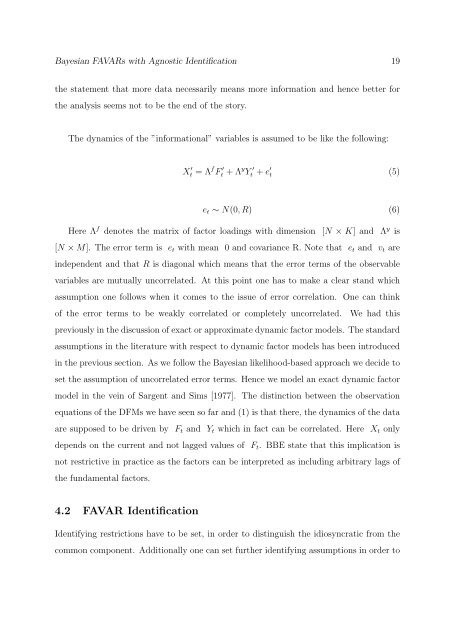

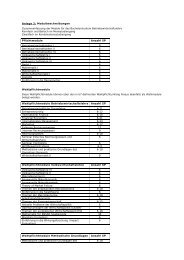

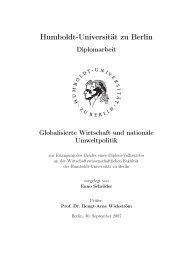
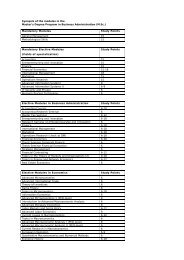
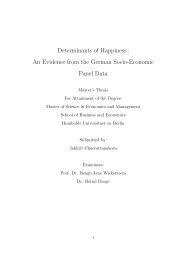
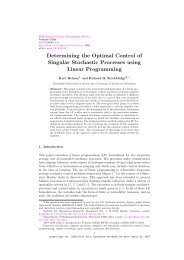
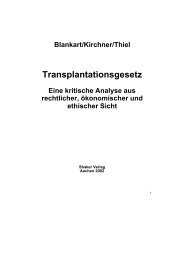


![[Text eingeben] [Text eingeben] Lebenslauf Anna-Maria Schneider](https://img.yumpu.com/16300391/1/184x260/text-eingeben-text-eingeben-lebenslauf-anna-maria-schneider.jpg?quality=85)

